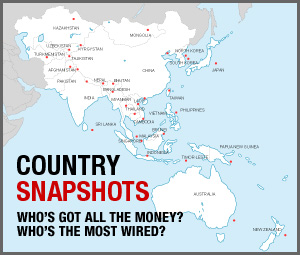Sun to set on US role in APAC?
 Image: Beverly & Pack
Image: Beverly & Pack
The Obama government has moved to build on these strengths, notably with a series of initiatives designed to remove obstacles to closer US cooperation with ASEAN and other Asian regional organizations. In addition, it has emphasised consultation and the inclusion of international stakeholders before coming to policy decisions on key regional issues, an approach that has been broadly welcomed and is in stark contrast to accusations of unilateralism under the previous US government.
In recent years, meanwhile, the US Pacific Command and other US military commands and organizations have been at the cutting edge of wide ranging and growing US efforts to build and strengthen webs of military relationships throughout the region. In an Asia-Pacific environment where the United States remains on generally good terms with major powers, and in fact most other governments, building military ties through education programs, on-site training and exercises enhances US influence in quiet but effective ways.
The success of these efforts is down in part to active contingency planning by many Asia-Pacific governments. As regional power relations evolve, notably in response to China’s rise, other governments are generally seeking to work positively and pragmatically with China on the one hand, while also looking for the reassurance of close security, intelligence and other ties with the United States in case China shifts from its current generally benign approach to one of greater assertiveness or even dominance.
Non-Government Engagement and Immigration
For much of its history, the United States exerted influence in the Asia-Pacific more through business, religious, educational and other interchange than via channels dependent on government leadership and support. Active US non-government interaction with the region continues today, leaving non-government US interests with a strong and usually positive impact on US regional influence. Meanwhile, over 40 years of generally colour-blind US immigration policy since the ending of discriminatory restrictions on Asian immigration in 1965 has resulted in the influx of millions of Asian migrants who call America home and who interact with their countries of origin in ways that reflect well on the United States. No other country, with the exception of Canada, has such an active and powerfully positive channel of influence in the Asia-Pacific.
US Irreplaceable
These four yardsticks demonstrate that the United States is deeply integrated in the Asia-Pacific at both the government and non-government level, while US security commitments and trade practices meet the fundamental security and economic needs of regional leaders. They know this, and they also know that neither a rising China nor any other power or coalition of powers is able or willing to meet even a small fraction of those needs.
Meanwhile, while China has no clear way of overcoming pervasive regional suspicion over its role, its leadership has continued to emphasize a narrow scope of national interests and tries to assure other nations that its policies and practices serve those interests. As a result, it tends to avoid the types of risks, costs and commitments in security and economic areas that underpin the US leadership role in the Asia-Pacific. This is occurring while China continues to run a substantial trade surplus and to accumulate large foreign exchange reserves that are supported by currency policies widely seen to disadvantage trading competitors in the region and elsewhere.
A further gripe with China is that despite its economic progress, it annually receives billions of dollars in foreign assistance loans and lesser grants from international organizations like the World Bank and the Asian Development Bank and from foreign government and non-government donors that presumably would otherwise be available for other deserving clients in the Asia-Pacific (and the world). It also carefully adheres to UN budget formulas that keep Chinese dues remarkably low for a country with such international prominence and development.
As a consequence, the ‘win-win’ principle that underscores recent Chinese foreign policy means, in effect, that Chinese officials make sure that their policies provide a ‘win’ for generally narrowly defined national interests of China, while eschewing the kinds of risky and costly commitments for the broader regional and global common good that Asia-Pacific leaders instead look to US leadership to provide.
All this said, the current US path is not set in stone–it could still decide to emphasize a narrower range of national interests and curb military and economic commitments that underpin its leadership position in the Asia-Pacific. Such a move toward ‘strategic withdrawal’ and economic protectionism has occurred before–following the US loss in Vietnam and the end of the Cold War. Still, so far at least, these tendencies have been notably absent (or at least muted) as US officials and broader public opinion recognize the continued importance of active engagement with a region of growing importance to US interests.










